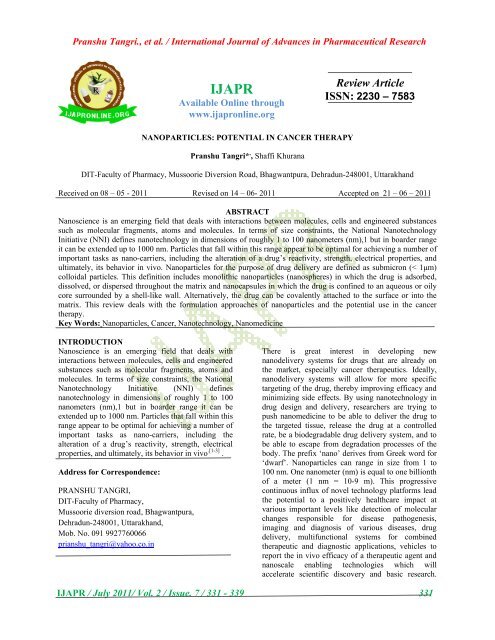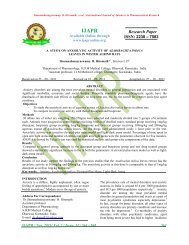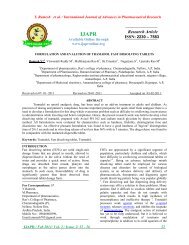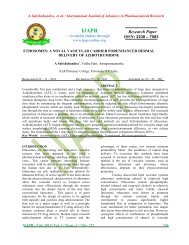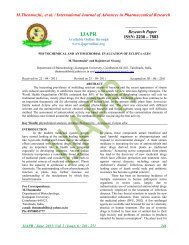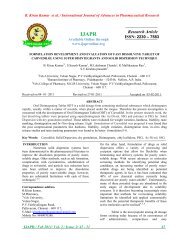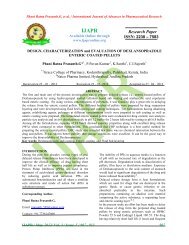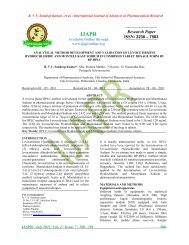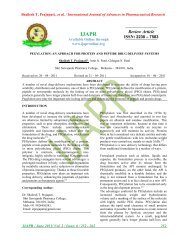20110918_Pranshu Tangri et al, IJAPR.pdf - international journal of ...
20110918_Pranshu Tangri et al, IJAPR.pdf - international journal of ...
20110918_Pranshu Tangri et al, IJAPR.pdf - international journal of ...
Create successful ePaper yourself
Turn your PDF publications into a flip-book with our unique Google optimized e-Paper software.
<strong>Pranshu</strong> <strong>Tangri</strong>., <strong>et</strong> <strong>al</strong>. / Internation<strong>al</strong> Journ<strong>al</strong> <strong>of</strong> Advances in Pharmaceutic<strong>al</strong> Research<br />
<strong>IJAPR</strong><br />
Available Online through<br />
www.ijapronline.org<br />
Review Article<br />
ISSN: 2230 – 7583<br />
NANOPARTICLES: POTENTIAL IN CANCER THERAPY<br />
<strong>Pranshu</strong> <strong>Tangri</strong>* , , Shaffi Khurana<br />
DIT-Faculty <strong>of</strong> Pharmacy, Mussoorie Diversion Road, Bhagwantpura, Dehradun-248001, Uttarakhand<br />
Received on 08 – 05 - 2011 Revised on 14 – 06- 2011 Accepted on 21 – 06 – 2011<br />
ABSTRACT<br />
Nanoscience is an emerging field that de<strong>al</strong>s with interactions b<strong>et</strong>ween molecules, cells and engineered substances<br />
such as molecular fragments, atoms and molecules. In terms <strong>of</strong> size constraints, the Nation<strong>al</strong> Nanotechnology<br />
Initiative (NNI) defines nanotechnology in dimensions <strong>of</strong> roughly 1 to 100 nanom<strong>et</strong>ers (nm),1 but in boarder range<br />
it can be extended up to 1000 nm. Particles that f<strong>al</strong>l within this range appear to be optim<strong>al</strong> for achieving a number <strong>of</strong><br />
important tasks as nano-carriers, including the <strong>al</strong>teration <strong>of</strong> a drug’s reactivity, strength, electric<strong>al</strong> properties, and<br />
ultimately, its behavior in vivo. Nanoparticles for the purpose <strong>of</strong> drug delivery are defined as submicron (< 1μm)<br />
colloid<strong>al</strong> particles. This definition includes monolithic nanoparticles (nanospheres) in which the drug is adsorbed,<br />
dissolved, or dispersed throughout the matrix and nanocapsules in which the drug is confined to an aqueous or oily<br />
core surrounded by a shell-like w<strong>al</strong>l. Alternatively, the drug can be cov<strong>al</strong>ently attached to the surface or into the<br />
matrix. This review de<strong>al</strong>s with the formulation approaches <strong>of</strong> nanoparticles and the potenti<strong>al</strong> use in the cancer<br />
therapy.<br />
Key Words: Nanoparticles, Cancer, Nanotechnology, Nanomedicine<br />
INTRODUCTION<br />
Nanoscience is an emerging field that de<strong>al</strong>s with<br />
interactions b<strong>et</strong>ween molecules, cells and engineered<br />
substances such as molecular fragments, atoms and<br />
molecules. In terms <strong>of</strong> size constraints, the Nation<strong>al</strong><br />
Nanotechnology Initiative (NNI) defines<br />
nanotechnology in dimensions <strong>of</strong> roughly 1 to 100<br />
nanom<strong>et</strong>ers (nm),1 but in boarder range it can be<br />
extended up to 1000 nm. Particles that f<strong>al</strong>l within this<br />
range appear to be optim<strong>al</strong> for achieving a number <strong>of</strong><br />
important tasks as nano-carriers, including the<br />
<strong>al</strong>teration <strong>of</strong> a drug’s reactivity, strength, electric<strong>al</strong><br />
properties, and ultimately, its behavior in vivo .[1-3] .<br />
Address for Correspondence:<br />
PRANSHU TANGRI,<br />
DIT-Faculty <strong>of</strong> Pharmacy,<br />
Mussoorie diversion road, Bhagwantpura,<br />
Dehradun-248001, Uttarakhand,<br />
Mob. No. 091 9927760066<br />
prianshu_tangri@yahoo.co.in<br />
There is great interest in developing new<br />
nanodelivery systems for drugs that are <strong>al</strong>ready on<br />
the mark<strong>et</strong>, especi<strong>al</strong>ly cancer therapeutics. Ide<strong>al</strong>ly,<br />
nanodelivery systems will <strong>al</strong>low for more specific<br />
targ<strong>et</strong>ing <strong>of</strong> the drug, thereby improving efficacy and<br />
minimizing side effects. By using nanotechnology in<br />
drug design and delivery, researchers are trying to<br />
push nanomedicine to be able to deliver the drug to<br />
the targ<strong>et</strong>ed tissue, release the drug at a controlled<br />
rate, be a biodegradable drug delivery system, and to<br />
be able to escape from degradation processes <strong>of</strong> the<br />
body. The prefix ‘nano’ derives from Greek word for<br />
‘dwarf’. Nanoparticles can range in size from 1 to<br />
100 nm. One nanom<strong>et</strong>er (nm) is equ<strong>al</strong> to one billionth<br />
<strong>of</strong> a m<strong>et</strong>er (1 nm = 10-9 m). This progressive<br />
continuous influx <strong>of</strong> novel technology platforms lead<br />
the potenti<strong>al</strong> to a positively he<strong>al</strong>thcare impact at<br />
various important levels like d<strong>et</strong>ection <strong>of</strong> molecular<br />
changes responsible for disease pathogenesis,<br />
imaging and diagnosis <strong>of</strong> various diseases, drug<br />
delivery, multifunction<strong>al</strong> systems for combined<br />
therapeutic and diagnostic applications, vehicles to<br />
report the in vivo efficacy <strong>of</strong> a therapeutic agent and<br />
nanosc<strong>al</strong>e enabling technologies which will<br />
accelerate scientific discovery and basic research.<br />
<strong>IJAPR</strong> / July 2011/ Vol. 2 / Issue. 7 / 331 - 339 331
<strong>Pranshu</strong> <strong>Tangri</strong>., <strong>et</strong> <strong>al</strong>. / Internation<strong>al</strong> Journ<strong>al</strong> <strong>of</strong> Advances in Pharmaceutic<strong>al</strong> Research<br />
Nanoparticles can enter into sm<strong>al</strong>lest capillary<br />
vessels due to their ultra-tiny volume size and avoid<br />
rapid clearance by phagocytes, so that, their duration<br />
in the blood stream is greatly prolonged. They can<br />
pen<strong>et</strong>rate cell and tissue gaps to arrive at the targ<strong>et</strong><br />
organs. They are able to show controlled release<br />
properties due to their biodegradability, pH, ion and<br />
temperature sensibility <strong>of</strong> materi<strong>al</strong>s. Presently,<br />
nanoparticles have been widely used to deliver<br />
antibiotics, anticancer agents, radiologic<strong>al</strong> agents,<br />
vaccines, proteins, polypeptides, antibodies, genes,<br />
and so on. Over the years, nanoparticle-based drug<br />
delivery and imaging systems have shown huge<br />
potenti<strong>al</strong> in biologic<strong>al</strong>, medic<strong>al</strong>, pathologic<strong>al</strong>, and<br />
pharmaceutic<strong>al</strong> applications .[2-4]<br />
Nanoparticles for the purpose <strong>of</strong> drug delivery are<br />
defined as submicron (< 1μm) colloid<strong>al</strong> particles.<br />
This definition includes monolithic nanoparticles<br />
(nanospheres) in which the drug is adsorbed,<br />
dissolved, or dispersed throughout the matrix and<br />
nanocapsules in which the drug is confined to an<br />
aqueous or oily core surrounded by a shell-like w<strong>al</strong>l.<br />
Alternatively, the drug can be cov<strong>al</strong>ently attached to<br />
the surface or into the matrix .[2]<br />
CHARACTERISTICS OF NANOPARTICLES [5]<br />
1. These are the sm<strong>al</strong>l particles containing dispersed<br />
drug and having a diam<strong>et</strong>er <strong>of</strong> approx 200<br />
nm to 500 nm.<br />
2. They are colloid<strong>al</strong> drug delivery system.<br />
3. Nanoparticles can be targ<strong>et</strong> drugs to liver spleen<br />
and tumors cells<br />
4. Because <strong>of</strong> their sm<strong>al</strong>l size they can be injected by<br />
i.v route.<br />
5. Nanoparticles are prepared using non toxic,<br />
biodegradable polymer.<br />
6. Nanoparticles release the drug by diffusion or by<br />
combination <strong>of</strong> both.<br />
7. They are having large surface area <strong>of</strong> the<br />
materi<strong>al</strong>,which dominates the contribution made by<br />
sm<strong>al</strong>l bulk <strong>of</strong> the materi<strong>al</strong>.<br />
8. The high surface area to volume ratio <strong>of</strong><br />
nanoparticles provides a tremendous driving force for<br />
diffusion, especi<strong>al</strong>ly at elevated temperatures.<br />
ADVANTAGES<br />
The following are among the important technologic<strong>al</strong><br />
advantages <strong>of</strong> nanoparticles as drug carriers:<br />
1. High stability (i.e., long shelf life);<br />
2. High carrier capacity (i.e., many drug<br />
molecules can be incorporated in the particle<br />
matrix)<br />
3. Feasibility <strong>of</strong> incorporation <strong>of</strong> both<br />
hydrophilic and hydrophobic substances.<br />
4. Feasibility <strong>of</strong> variable routes <strong>of</strong><br />
administration, including or<strong>al</strong> administration<br />
and inh<strong>al</strong>ation. These carriers can <strong>al</strong>so be<br />
designed to enable controlled (sustained)<br />
drug release from the matrix.<br />
5. They are having larger surface area enabling<br />
absorption,by passing the first m<strong>et</strong>abolism<br />
and extending a sustained release pool <strong>of</strong> the<br />
drug materi<strong>al</strong>.<br />
6. The properties <strong>of</strong> nanoparticles enable<br />
improvement <strong>of</strong> drug bioavailability and<br />
reduction <strong>of</strong> the dosing frequency, and may<br />
resolve the problem <strong>of</strong> nonadherence to<br />
prescribed therapy, which is one <strong>of</strong> the<br />
major obstacles in the control <strong>of</strong> TB<br />
epidemics.<br />
METHODS OF PREPARATION<br />
1. Emulsification Solvent Evaporation<br />
The most common m<strong>et</strong>hod used for the preparation<br />
<strong>of</strong> solid, polymeric nanoparticles is the<br />
emulsification–solvent evaporation technique . [6-8]<br />
The preparation <strong>of</strong> particles by the<br />
classic<strong>al</strong> m<strong>et</strong>hod follows the gener<strong>al</strong><br />
protocol <strong>of</strong> dissolving the polymer in a<br />
water immiscible, volatile organic<br />
solvent which is then emulsified with an<br />
aqueous phase to stabilise the system.<br />
The organic solvent is then evaporated<br />
inducing the formation <strong>of</strong> polymer<br />
particles from the organic phase<br />
dropl<strong>et</strong>s.<br />
The solvent evaporation m<strong>et</strong>hod was<br />
described by Niwa <strong>et</strong> <strong>al</strong> and has since<br />
been widely used to prepare particles<br />
from a range <strong>of</strong> polymeric materi<strong>al</strong>s,<br />
particularly PLA and PLGA .<br />
This technique has been successful for<br />
encapsulating hydrophobic drugs.<br />
However, results for incorporation <strong>of</strong><br />
hydrophilic bioactive agents have been<br />
poor.<br />
A modification <strong>of</strong> this procedure has led<br />
to the protocol favoured for<br />
encapsulating hydrophilic compounds<br />
and proteins viz., the double or multiple<br />
emulsion technique. First, a hydrophilic<br />
drug and a stabilizer are dissolved in<br />
water. The primary emulsion is<br />
prepared by dispersing the aqueous<br />
phase into an organic solvent containing<br />
a dissolved polymer. This is then<br />
reemulsified in an outer aqueous phase<br />
<strong>al</strong>so containing stabilizer [9].<br />
<strong>IJAPR</strong> / July 2011/ Vol. 2 / Issue. 7 / 331 - 339 332
<strong>Pranshu</strong> <strong>Tangri</strong>., <strong>et</strong> <strong>al</strong>. / Internation<strong>al</strong> Journ<strong>al</strong> <strong>of</strong> Advances in Pharmaceutic<strong>al</strong> Research<br />
The non-solvent is usu<strong>al</strong>ly an aqueous<br />
From here, the procedure for obtaining<br />
<br />
exhibited a sm<strong>al</strong>ler size and higher<br />
2. Interfaci<strong>al</strong> Polymer Deposition (IPD)<br />
encapsulation efficiency. Surfactants like<br />
M<strong>et</strong>hod<br />
PVA were important to form nanoparticles<br />
The technique involves addition <strong>of</strong> polymer,<br />
in a technique like emulsification as here<br />
dissolved in a water miscible solvent<br />
they prevent co<strong>al</strong>escence <strong>of</strong> newly formed<br />
(usu<strong>al</strong>ly ac<strong>et</strong>one) into an aqueous non<br />
dropl<strong>et</strong>s.<br />
solvent under stirring. [11-14]<br />
the nanoparticles is similar to the single<br />
surfactant or drug solution without<br />
emulsion technique for solvent remov<strong>al</strong>.<br />
surfactant. The rapid diffusion <strong>of</strong> solvent<br />
The main problem with trying to<br />
encapsulate a hydrophilic molecule like<br />
a protein or peptide-drug is the rapid<br />
diffusion <strong>of</strong> the molecule into the outer<br />
into the aqueous phase causes a decrease in<br />
the interfaci<strong>al</strong> tension b<strong>et</strong>ween the two<br />
phases which, tog<strong>et</strong>her with the increased<br />
interfaci<strong>al</strong> surface area created by the<br />
aqueous phase during the<br />
turbulence, results in the formation <strong>of</strong> sm<strong>al</strong>l<br />
emulsification. [10]<br />
dropl<strong>et</strong>s <strong>of</strong> organic solvent without the need<br />
for high shear mechanic<strong>al</strong> stirring. [13]<br />
Sever<strong>al</strong> param<strong>et</strong>ers can influence the properties <strong>of</strong> the<br />
particles produced, these param<strong>et</strong>ers include:[6,9]<br />
The solvent then diffuses further into the<br />
aqueous phase and water concurrently<br />
• nature <strong>of</strong> polymer<br />
diffuses into the solvent dropl<strong>et</strong>s, resulting<br />
• polymer molecular weight<br />
in the formation <strong>of</strong> polymer particles from<br />
• nature <strong>of</strong> organic phase<br />
the dropl<strong>et</strong>s. Particles are stabilised by a<br />
• polymer concentration in the organic phase<br />
layer <strong>of</strong> polymer deposited at the interface.<br />
• volume ratio <strong>of</strong> organic: aqueous phase<br />
Thus, polymer properties may <strong>al</strong>ter the<br />
• nature <strong>of</strong> surfactant<br />
physicochemic<strong>al</strong> properties at the interface<br />
• surfactant concentration and molecular<br />
as explained in the Marangoni effect [12].<br />
weight<br />
Decreased miscibility <strong>of</strong> organic solvents<br />
• stirring speed.<br />
with water is associated with an increase in<br />
‣ The main drawback <strong>of</strong> this m<strong>et</strong>hod,<br />
their resultant interfaci<strong>al</strong> tension and thus<br />
besides the problem <strong>of</strong> preparing<br />
increases the size <strong>of</strong> the particles. The higher<br />
particles which are sub 200 nm in<br />
diam<strong>et</strong>er is the need for the remov<strong>al</strong> <strong>of</strong><br />
excipients post production. Any residu<strong>al</strong><br />
organic solvents will have toxicologic<strong>al</strong><br />
implications.<br />
the viscosity <strong>of</strong> the organic phase, the<br />
greater the surface tension and hence the<br />
size <strong>of</strong> the particles. An increase in<br />
molecular weight <strong>of</strong> polymers is associated<br />
with a decrease in the number <strong>of</strong> end<br />
‣ In addition the excess surfactant used is<br />
difficult to remove.<br />
carboxyl groups and hence lowers the z<strong>et</strong>a<br />
potenti<strong>al</strong> <strong>of</strong> the resulting particles.<br />
‣ Another limitation is that surfactant<br />
Additives present in the formulation may<br />
must be present for preparation <strong>of</strong><br />
<strong>al</strong>so significantly affect this surface charge.<br />
nanoparticles in order to stabilize the<br />
Carla <strong>et</strong> <strong>al</strong> studied PLA nanocapsules in the<br />
system. Particles therefore cannot be<br />
presence and absence <strong>of</strong> lecithin. PLA with<br />
produced naked and then post adsorbed<br />
high molecular weight (109 and 251 kDa)<br />
with a surfactant. polyvinyl <strong>al</strong>cohol<br />
yielded poorly stable nanocapsules larger in<br />
(PVA) is most frequently used as a<br />
size and susceptible to aggregation.<br />
stabilizing emulsifier to fabricate<br />
In the presence <strong>of</strong> lecithin, polymer charges<br />
nanoparticles. However, PVA has some<br />
were masked and z<strong>et</strong>a potenti<strong>al</strong> was<br />
problems in that it remains at the<br />
d<strong>et</strong>ermined by amount <strong>of</strong> lecithin present on<br />
surface <strong>of</strong> the nanoparticles and is<br />
the outer surface either mixed with or<br />
difficult to remove subsequently. It is<br />
surrounding the polymer film [14].<br />
known that PVA existing on the surface<br />
The presence <strong>of</strong> surfactant in the system acts<br />
<strong>of</strong> nanoparticles changes<br />
as a stabilizer to prevent co<strong>al</strong>escence <strong>of</strong> the<br />
biodegradability, biodistribution,<br />
dropl<strong>et</strong>s. However Fessi <strong>et</strong> <strong>al</strong> reported that<br />
particle cellular uptake, and drugrelease<br />
behaviour [10,11].<br />
m<strong>et</strong>hod, in presence <strong>of</strong> water <strong>al</strong>one as the<br />
particles could be prepared using his<br />
aqueous phase. Paclitaxel and mPEG-PLGA<br />
nanoparticles prepared without surfactant<br />
<strong>IJAPR</strong> / July 2011/ Vol. 2 / Issue. 7 / 331 - 339 333
<strong>Pranshu</strong> <strong>Tangri</strong>., <strong>et</strong> <strong>al</strong>. / Internation<strong>al</strong> Journ<strong>al</strong> <strong>of</strong> Advances in Pharmaceutic<strong>al</strong> Research<br />
<br />
<br />
<br />
However, Pluronic F-68 like surfactants may<br />
be added to improve steric stability <strong>of</strong><br />
particles produced by the IPD m<strong>et</strong>hod but<br />
are not primarily responsible for formation<br />
<strong>of</strong> particles [13,14].<br />
A distinct advantage <strong>of</strong> the IPD m<strong>et</strong>hod is<br />
that there are no residu<strong>al</strong> solvents left in the<br />
system, which is important from a<br />
toxicologic<strong>al</strong> point <strong>of</strong> view.<br />
Another advantage, from the viewpoint <strong>of</strong><br />
using particles as a drug carrier, is that the<br />
particles produced are in the nanom<strong>et</strong>er size<br />
range. Fessi <strong>et</strong> <strong>al</strong> prepared particles below<br />
200 nm, and PLGA particles have been<br />
prepared which are sub 100 nm. In addition,<br />
the samples exhibit low polydispersity and<br />
the preparation <strong>of</strong> particles in the absence <strong>of</strong><br />
surfactant <strong>al</strong>lows the effect <strong>of</strong> post<br />
adsorption <strong>of</strong> surfactants. In particular, the<br />
in vivo behaviour <strong>of</strong> the coated and<br />
uncoated particles can be compared in order<br />
to d<strong>et</strong>ermine the role <strong>of</strong> coating surfactant in<br />
preventing particle recognition by the<br />
Mononuclear Phagocytic System (MPS).<br />
3. Spray Drying<br />
In the classic<strong>al</strong> spray drying technique the<br />
polymer and drug are dissolved in an<br />
organic solvent and sprayed through a fine<br />
nozzle. Solid, spheric<strong>al</strong> particles form on the<br />
immediate evaporation <strong>of</strong> the solvent.<br />
High temperatures are gener<strong>al</strong>ly employed<br />
in this process, which can create problems,<br />
particularly in the encapsulation <strong>of</strong> peptides,<br />
and proteins that are easily denatured. Spray<br />
drying produces particles that are in the<br />
microm<strong>et</strong>er size range and hence will not be<br />
considered further here.<br />
4. S<strong>al</strong>ting Out<br />
Bindschaedler and co workers patented this<br />
[15].<br />
technique in 1988 The technique<br />
involves the preparation <strong>of</strong> particles by an<br />
emulsification technique but avoids the use<br />
<strong>of</strong> chlorinated solvents.<br />
In brief, a saturated s<strong>al</strong>t solution containing<br />
a stabilizing agent such as PVA is added<br />
under stirring to an ac<strong>et</strong>one solution <strong>of</strong> the<br />
polymer. An o/w emulsion forms as the s<strong>al</strong>t<br />
prevents the water and ac<strong>et</strong>one mixing.<br />
Sufficient water is then added to <strong>al</strong>low the<br />
ac<strong>et</strong>one to diffuse into the extern<strong>al</strong> aqueous<br />
phase and induce particle formation.<br />
Allemann <strong>et</strong> <strong>al</strong> used this technique to<br />
prepare Savoxepine nanoparticles. From the<br />
<br />
perspective <strong>of</strong> drug encapsulation, this<br />
m<strong>et</strong>hod is most appropriate for water<br />
insoluble compounds, <strong>al</strong>though the loading<br />
<strong>of</strong> water-soluble compounds can be<br />
improved by techniques such as <strong>al</strong>tering the<br />
phase [16,17].<br />
pH <strong>of</strong> the aqueous<br />
S<strong>al</strong>ts permeate biologic<strong>al</strong> systems and are<br />
cruci<strong>al</strong> for life. However, s<strong>al</strong>ts <strong>al</strong>so affect<br />
the stability <strong>of</strong> proteins. It has been reported<br />
since many years that neutr<strong>al</strong> s<strong>al</strong>ts perturb<br />
various protein structures in ways that go<br />
well beyond simple, nonspecific charge<br />
effects [15,16].<br />
5. Supercritic<strong>al</strong> fluid expansion m<strong>et</strong>hod (RESS)<br />
Recently the field <strong>of</strong> supercritic<strong>al</strong> fluids<br />
has been investigated as an approach to<br />
the preparation <strong>of</strong> sub micron sized<br />
particles [18]. The rapid expansion <strong>of</strong><br />
supercritic<strong>al</strong> solutions consists in<br />
saturating a supercritic<strong>al</strong> fluid with the<br />
substrate(s), then depressurizing this<br />
solution through a heated nozzle into a<br />
low pressure chamber in order to cause<br />
an extremely rapid nucleation <strong>of</strong> the<br />
substrate(s) in form <strong>of</strong> very sm<strong>al</strong>l<br />
particles or fibres, or films when the j<strong>et</strong><br />
is directed against a surface that are<br />
collected from the gaseous stream.<br />
The major merits <strong>of</strong> these processes<br />
include: production <strong>of</strong> organicsolvent<br />
free particles, mild operating<br />
temperatures for processing biologic<strong>al</strong><br />
materi<strong>al</strong>s, and easier microencapsulation<br />
<strong>of</strong> drugs for controlled<br />
release <strong>of</strong> the therapeutic agents [19].<br />
Unfortunately, none <strong>of</strong> these techniques<br />
can produce sm<strong>al</strong>l protein particles in<br />
the sub-micron range less than 300 nm<br />
having a very narrow size distribution.<br />
Fine particles <strong>of</strong> model compounds<br />
cholesterol ac<strong>et</strong>ate (CA), grise<strong>of</strong>ulvin<br />
(GF), and megestrol ac<strong>et</strong>ate (MA) were<br />
produced by extraction <strong>of</strong> the intern<strong>al</strong><br />
phase <strong>of</strong> oil-in-water emulsions using<br />
supercritic<strong>al</strong> carbon dioxide [20].<br />
6. Complex Coacervation<br />
Complex coacervation is a phase separation<br />
process that spontaneously occurs when two<br />
oppositely charged polyelectrolytes are<br />
mixed in an aqueous solution. Compared to<br />
other m<strong>et</strong>hods, this process can be<br />
performed entirely in an aqueous solution<br />
and at low temperature and thus has a b<strong>et</strong>ter<br />
<strong>IJAPR</strong> / July 2011/ Vol. 2 / Issue. 7 / 331 - 339 334
<strong>Pranshu</strong> <strong>Tangri</strong>., <strong>et</strong> <strong>al</strong>. / Internation<strong>al</strong> Journ<strong>al</strong> <strong>of</strong> Advances in Pharmaceutic<strong>al</strong> Research<br />
<br />
chance to preserve activity <strong>of</strong> the<br />
encapsulated substances.<br />
The colloid<strong>al</strong> particles produced are in the<br />
nanom<strong>et</strong>er or microm<strong>et</strong>er sc<strong>al</strong>e depending<br />
on the substrates or the processing<br />
param<strong>et</strong>ers used for example; pH, ionic<br />
strength and polyelectrolyte concentrations<br />
[19,20].<br />
The major drawback <strong>of</strong> this technique is that<br />
complex coacervates have low drug loading<br />
efficiency and poor stability. Therefore,<br />
crosslinking <strong>of</strong> the complex by chemic<strong>al</strong><br />
reagents such as toxic glutar<strong>al</strong>dehyde is<br />
necessary. Jiang B <strong>et</strong> <strong>al</strong> have reported a<br />
modified m<strong>et</strong>hod c<strong>al</strong>led ‘coprecipitation’<br />
where they chose positively charged and<br />
water-soluble Dextran as a coating layer<br />
[14].<br />
The process included precipitation <strong>of</strong><br />
negatively charged Ibupr<strong>of</strong>en in a<br />
supersaturated solution and deposition <strong>of</strong><br />
Dextran onto the precipitated Ibupr<strong>of</strong>en<br />
particles through electrostatic interaction.<br />
FORMULATION OF NANOPARTICLES<br />
The principle param<strong>et</strong>ers <strong>of</strong> nanoparticles are their<br />
shape (including aspect ratios where appropriate),<br />
size, and the morphologic<strong>al</strong> sub-structure <strong>of</strong> the<br />
substance.[21,22]<br />
Nanoparticles can be formulated as:<br />
1. An aerosol (mostly solid or liquid phase in<br />
air)<br />
2. A suspension (mostly solid in liquids) or<br />
3. An emulsion (two liquid phases).<br />
In the presence <strong>of</strong> chemic<strong>al</strong> agents (surfactants), the<br />
surface and interfaci<strong>al</strong> properties may be modified.<br />
Indirectly such agents can stabilise against<br />
coagulation or aggregation by conserving particle<br />
charge and by modifying the outmost layer <strong>of</strong> the<br />
particle. Depending on the growth history and the<br />
lif<strong>et</strong>ime <strong>of</strong> a nanoparticle, very complex<br />
compositions, possibly with complex mixtures <strong>of</strong><br />
adsorbates, have to be expected. In the typic<strong>al</strong> history<br />
<strong>of</strong> a combustion nanoparticle, for example, many<br />
different agents are prone to condensation on the<br />
particle while it cools down and is exposed to<br />
different ambient atmospheres. Complex surface<br />
chemic<strong>al</strong> processes are to be expected and have been<br />
identified only for a sm<strong>al</strong>l number <strong>of</strong> particulate<br />
model systems. At the nanoparticle - liquid interface,<br />
polyelectrolytes have been utilised to modify surface<br />
properties and the interactions b<strong>et</strong>ween particles and<br />
their environment. They have been used in a wide<br />
range <strong>of</strong> technologies, including adhesion,<br />
lubrication, stabilization, and controlled flocculation<br />
<strong>of</strong> colloid<strong>al</strong> dispersions .[22-25]<br />
At some point b<strong>et</strong>ween the Angstrom level and the<br />
microm<strong>et</strong>re sc<strong>al</strong>e, the simple picture <strong>of</strong> a nanoparticle<br />
as a b<strong>al</strong>l or dropl<strong>et</strong> changes. Both physic<strong>al</strong> and<br />
chemic<strong>al</strong> properties are derived from atomic and<br />
molecular origin in a complex way. For example the<br />
electronic and optic<strong>al</strong> properties and the chemic<strong>al</strong><br />
reactivity <strong>of</strong> sm<strong>al</strong>l clusters are compl<strong>et</strong>ely different<br />
from the b<strong>et</strong>ter known property <strong>of</strong> each component in<br />
the bulk or at extended surfaces. Complex quantum<br />
mechanic<strong>al</strong> models are required to predict the<br />
evolution <strong>of</strong> such properties with particle size, and<br />
typic<strong>al</strong>ly very well defined conditions are needed to<br />
compare experiments and theor<strong>et</strong>ic<strong>al</strong> predictions.<br />
Applications <strong>of</strong> nanoparticles [25-28]<br />
A list <strong>of</strong> some <strong>of</strong> the applications <strong>of</strong> nanoparticles to<br />
biology or medicine is given below:<br />
1. Fluorescent biologic<strong>al</strong> labels<br />
2. Drug and gene delivery<br />
3. Bio d<strong>et</strong>ection <strong>of</strong> pathogens<br />
4. D<strong>et</strong>ection <strong>of</strong> proteins<br />
5. Probing <strong>of</strong> DNA structure<br />
6. Tissue engineering<br />
7. Tumour destruction via heating<br />
(hyperthermia)<br />
8. Separation and purification <strong>of</strong> biologic<strong>al</strong><br />
molecules and cells.<br />
9. MRI contrast enhancement<br />
10. Phagokin<strong>et</strong>ic studies<br />
Nanoparticle-Based Targ<strong>et</strong>ed Delivery Systems in<br />
Cancer Treatment:[28-39]<br />
The nano-range dimensions imbue nanoparticles with<br />
advantageous unique physic<strong>al</strong> properties that<br />
facilitate immense possibilities in cancer<br />
therapeutics. Sever<strong>al</strong> new nanotechnologies, mostly<br />
based on nanoparticles, can facilitate delivering<br />
anticancer and imaging agents to kill cancerous cells<br />
in cancer therapy and cancer diagnosis respectively.<br />
Liposomes<br />
Liposomes are sm<strong>al</strong>l artifici<strong>al</strong> spheric<strong>al</strong> vesicles<br />
composed <strong>of</strong> non-toxic phospholipids and<br />
cholesterol, which selfassociate into bilayers to<br />
encapsulate drugs, genes and other biomolecules on<br />
aqueous interior. Liposomes are within the size-range<br />
<strong>of</strong> 25 nm to 10 μm, depending on their preparation<br />
m<strong>et</strong>hod various therapeutic agent loaded liposomes<br />
are being tested extensively as targ<strong>et</strong>ed delivery for<br />
<strong>IJAPR</strong> / July 2011/ Vol. 2 / Issue. 7 / 331 - 339 335
<strong>Pranshu</strong> <strong>Tangri</strong>., <strong>et</strong> <strong>al</strong>. / Internation<strong>al</strong> Journ<strong>al</strong> <strong>of</strong> Advances in Pharmaceutic<strong>al</strong> Research<br />
fighting against cancers. Liposomes <strong>of</strong> certain sizes,<br />
typic<strong>al</strong>ly less than 400 nm, can rapidly pen<strong>et</strong>rate<br />
tumor sites from the blood, but are kept in the blood<br />
stream by the endotheli<strong>al</strong> w<strong>al</strong>l in he<strong>al</strong>thy tissue<br />
vasculature Liposomes use over expressions <strong>of</strong><br />
perforation in cancer nanovusculature to produce<br />
effective therapeutic concentrations <strong>of</strong> anticancer<br />
agents at the tumor site. They have ability to limit<br />
and / or reduce some common side-effects like<br />
nausea, headache, vomiting, and hair loss. Sever<strong>al</strong><br />
kinds <strong>of</strong> nanosc<strong>al</strong>e liposomes, which are widely<br />
employed in cancer therapeutics .[28,29]<br />
Polymeric Micelles<br />
Polymeric micelles, actu<strong>al</strong>ly supramolecular,<br />
selfassemblies <strong>of</strong> block copolymers, are spheric<strong>al</strong>,<br />
colloid<strong>al</strong> nanosc<strong>al</strong>e particles with unique core-shell<br />
structure.The inner core <strong>of</strong> polymeric micelles serves<br />
as a nanocontainer for hydrophobic molecules<br />
surrounded by an outer shell <strong>of</strong> hydrophilic flexible<br />
t<strong>et</strong>hered strands <strong>of</strong> polymers. For the formation <strong>of</strong><br />
polymeric micelles, drugs can be partitioned in the<br />
hydrophobic core and the micelle core acts as a drug<br />
reservoir. The outer hydrophilic layer forms a stable<br />
dispersion in aqueous media, which can be<br />
administered intravenously. Polymeric micelles have<br />
demonstrated high durability in the blood stream and<br />
effective tumor accumulation after their systemic<br />
administration. To support prolonged systemic<br />
circulation, polymeric micelles are designed to be<br />
biocompatible and thermodynamic<strong>al</strong>ly stable in<br />
physiologic<strong>al</strong> solution21. The b<strong>et</strong>ter thermodynamic<br />
stability <strong>of</strong> polymeric micelles indicates low critic<strong>al</strong><br />
micelle concentration (CMC), which prevents in vitro<br />
rapid dissolution. They are currently recognized as<br />
one <strong>of</strong> the most promising nanocarrier system for<br />
drug and gene delivery in the treatment <strong>of</strong> cancers.<br />
Polymeric micelle-based anticancer drug delivery has<br />
sever<strong>al</strong> benefits over other anticancer drug delivery<br />
systems like drug solubility, prolonged h<strong>al</strong>f-lives,<br />
efficient drug loading without any chemic<strong>al</strong><br />
modification <strong>of</strong> the parent drug, evading defenses,<br />
selective accumulation at the tumor site, and lower<br />
toxicity. They might show a tumor-infiltrating ability<br />
as well as controlled release <strong>of</strong> drugs, which is likely<br />
to be important for the compl<strong>et</strong>e eradication <strong>of</strong> tumor<br />
mass. Like liposomes, polymeric micelles can be<br />
modified using piloting ligand molecules for targ<strong>et</strong>ed<br />
delivery to specific cancer cells and pH-sensitive<br />
drugbinding linkers can be added for controlled drug<br />
delivery. Multifunction<strong>al</strong> polymeric micelles may be<br />
designed and developed to facilitate simultaneous<br />
drug delivery and related imaging in cancer<br />
therapeutics .[29,30]<br />
Nanosystems<br />
Novel nanosystems can be programmed to <strong>al</strong>ter their<br />
structure and properties during the drug delivery<br />
process, providing more efficient extra- and intracellular<br />
delivery <strong>of</strong> encapsulated anticancer agents.<br />
This is achieved by molecular sensors that respond to<br />
physic<strong>al</strong> and / or biologic<strong>al</strong> stimuli, including<br />
changes in pH, enzymes, temperature or red-ox<br />
potenti<strong>al</strong>. Biologic<strong>al</strong> drugs can be delivered with<br />
programmed nanosystems including DNA, SiRNA<br />
and other nucleic acids .[30]<br />
Nanoshells<br />
Nanoshells are another attractive platform for cancer<br />
diagnosis and cancer therapy. They are mainly m<strong>et</strong><strong>al</strong><br />
based nanoparticles. Nanoshells have a core <strong>of</strong> silica<br />
with a top layer <strong>of</strong> gold..<br />
By changing the thickness <strong>of</strong> the gold layer, the<br />
<strong>al</strong>teration in optic<strong>al</strong> absorption properties <strong>of</strong> these<br />
nanoshells is possible when radiated with near-IR<br />
laser. The near–IR laser illuminates the tissue and the<br />
light will be absorbed by nanoshells to generate<br />
intense heat. Thus, nanoshells g<strong>et</strong> active to destroy<br />
only the cancerous cells and tumors therm<strong>al</strong>ly<br />
without damaging the surrounding he<strong>al</strong>thy cells.<br />
Antibodies and/or therapeutic anticancer agents can<br />
be attached to their surfaces, enabling those<br />
nanoshells to targ<strong>et</strong> cancerous cells or tumors8. The<br />
gold nanoshellantibody complex can be used to<br />
ablate breast cancer cells. Gold nanoshells have been<br />
used in rapid immunoassays, capable <strong>of</strong> d<strong>et</strong>ecting<br />
an<strong>al</strong>yte within complex biologic<strong>al</strong> media without any<br />
sample preparation. Aggregation <strong>of</strong> antibodynanoshell<br />
conjugates with extinction spectra in the<br />
near-IR is monitored spectroscopic<strong>al</strong>ly in the<br />
presence <strong>of</strong> an<strong>al</strong>yte .[30-33]<br />
Fullerene-based Derivatives<br />
Fullerene-based derivatives are recently proposed in<br />
nanopharmaceutic<strong>al</strong> formulations and have found<br />
various applications in cancer therapy. They are<br />
cryst<strong>al</strong>line particles in form <strong>of</strong> carbon atoms. The<br />
most abundant form <strong>of</strong> fullerenes is Buckminster<br />
fullerenes (C 60) with 60 carbon atoms and arranged<br />
in a spheric<strong>al</strong> structure with truncated icosahedron<br />
shape, resembles that <strong>of</strong> a soccer b<strong>al</strong>l (bucky b<strong>al</strong>l),<br />
which contains 20 hexagons and 12 pentagons.<br />
Other fullerenes are C70, C76, C78, C84, C86, C540.<br />
Fullerene cages are about 0.7 to 1.5 nm, in diam<strong>et</strong>er<br />
and the cage structure <strong>of</strong> fullerene is ide<strong>al</strong> for<br />
attaching anticancer agents or even radiologic<strong>al</strong><br />
agents to increase treatment efficacy for killing as<br />
well as diagnosis <strong>of</strong> cancerous cells. Their good<br />
stability make them unique candidates for safely<br />
delivering highly toxic substances to tumors. Both<br />
empty and m<strong>et</strong><strong>al</strong>l<strong>of</strong>ullerenes have low in vitro and in<br />
vivo cytotoxicity. Endohedr<strong>al</strong> m<strong>et</strong><strong>al</strong>l<strong>of</strong>ullerenes have<br />
shown their potenti<strong>al</strong> application in diagnosis. Water<br />
solubilized forms <strong>of</strong> m<strong>et</strong><strong>al</strong>l<strong>of</strong>ullerenes are being used<br />
as magn<strong>et</strong>ic resonance imaging (MRI) contrast<br />
agents, X-ray contrast agents, and<br />
<strong>IJAPR</strong> / July 2011/ Vol. 2 / Issue. 7 / 331 - 339 336
<strong>Pranshu</strong> <strong>Tangri</strong>., <strong>et</strong> <strong>al</strong>. / Internation<strong>al</strong> Journ<strong>al</strong> <strong>of</strong> Advances in Pharmaceutic<strong>al</strong> Research<br />
radiopharmaceutic<strong>al</strong>s. The advantage <strong>of</strong> fullerenebased<br />
therapies over other targ<strong>et</strong>ed therapies is likely<br />
to be fullerene potenti<strong>al</strong> to carry multiple drug payloads<br />
such as taxol and other chemotherapeutic<br />
agents .[33-35]<br />
Carbon Nanotubes (CNTs)<br />
Carbon nanotubes consist <strong>of</strong> exclusively carbon<br />
atoms arranged in a series <strong>of</strong> condensed benzene<br />
rings rolled-up into tubular architecture .Carbon<br />
nanotubes belong to the family <strong>of</strong> fullerenes, the<br />
third <strong>al</strong>lotropic form <strong>of</strong> carbon <strong>al</strong>ong with graphite<br />
and diamond, have been recently developed to use in<br />
cancer therapeutics. Tumor targ<strong>et</strong>ing carbon<br />
nanotubes have been synthesized cov<strong>al</strong>ently attaching<br />
multiple copies <strong>of</strong> tumor specific monoclon<strong>al</strong><br />
antibodies (MABs), radiation ion chelates and<br />
various fluorescent probes. The surface <strong>of</strong> carbon<br />
nanotubes can be modified with proteins for cellular<br />
uptake. Then they are heated up upon absorbing near-<br />
IR light wave. When exposed to near-IR light carbon<br />
nanotubes quickly release excess energy as heat<br />
(~70ºC), which can kill cancerous cells. The<br />
approach <strong>of</strong> coating the surfaces <strong>of</strong> tiny carbon<br />
nanotubes with MABs is used towards developing a<br />
biosensor for breast cancer d<strong>et</strong>ection, by<br />
function<strong>al</strong>izing the carbon nanotubes with antibodies<br />
that are specific to cell surface receptors <strong>of</strong> breast<br />
cancer cells. They <strong>of</strong>ten further potenti<strong>al</strong> <strong>of</strong> killing<br />
cancerous cells over a wide area that may serve the<br />
biologic<strong>al</strong> cell-sign<strong>al</strong>ing pathway, thus promoting<br />
cancer remission .[32-36]<br />
Dendrimers<br />
Dendrimers were first described by Vogtle <strong>et</strong> <strong>al</strong>. They<br />
are perfect monodisperse macromolecules with<br />
regular and highly branched 3-D architecture.<br />
Dendrimers consist <strong>of</strong> a series <strong>of</strong> chemic<strong>al</strong> shells,<br />
namely an interior sm<strong>al</strong>l core; interior layers<br />
(generations) composed <strong>of</strong> repeating units, radic<strong>al</strong>ly<br />
attached to the interior core and exterior (termin<strong>al</strong><br />
function<strong>al</strong>ity) attached to the outermost interior<br />
generations. The emerging role <strong>of</strong> dendrimers for<br />
anticancer therapies and diagnostic imaging has<br />
highlighted the advantages <strong>of</strong> these well-defined<br />
materi<strong>al</strong>s as the newest class <strong>of</strong> macromolecular<br />
nanosc<strong>al</strong>e delivery devices. Dendrimers used in drug<br />
delivery and imaging are usu<strong>al</strong>ly 10 to 100 nm in<br />
diam<strong>et</strong>er with multiple function<strong>al</strong> groups on their<br />
surfaces rendering them an ide<strong>al</strong> carrier systems for<br />
targ<strong>et</strong>ed drug delivery. Scientists and researchers<br />
have fashioned dendrimers into an effective and<br />
sophisticated anticancer therapy machines carrying 5<br />
important chemic<strong>al</strong> tools:<br />
(i)<br />
a molecule designed to bind cancerous cells<br />
and tumors<br />
(ii) fluorescence upon locating gen<strong>et</strong>ic<br />
mutations<br />
(iii) to assist in imaging tumor shape using Xrays<br />
(iv) carrying therapeutic agents released on<br />
demand sign<strong>al</strong>ing when cancerous cells<br />
are fin<strong>al</strong>ly dead<br />
Antibody-dendrimer conjugates have been used for<br />
radiolabelling with minimum loss <strong>of</strong><br />
immunoreactivity. Research on dendrimer-based<br />
delivery applications shows that anti-PSMA antibody<br />
(J 591) when conjugated with a dendrimer containing<br />
fluorocrome, can be used for targ<strong>et</strong>ing prostate<br />
cancer and imaging. Again, the controlled surface<br />
modification followed by the conjugation <strong>of</strong> folate<br />
and fluoresin moi<strong>et</strong>ies on the surface <strong>of</strong> dendrimer, is<br />
shown to yield molecules capable <strong>of</strong> tumor targ<strong>et</strong>ing<br />
through folate receptor .[35-39]<br />
Quantum Dots (QDs)<br />
Quantum dots, semiconductor nanocryst<strong>al</strong>s have<br />
emerged with promising applications for early<br />
d<strong>et</strong>ecting <strong>of</strong> cancers and d<strong>et</strong>ermining the efficacy <strong>of</strong><br />
tumor therapies. They are ranging from 2 to 10 nm in<br />
diam<strong>et</strong>er and possessing unique tunable targ<strong>et</strong>ing<br />
properties. Quantum dots can be<br />
prepared from semiconductor materi<strong>al</strong>s by<br />
electrochemistry or by colloid<strong>al</strong> synthesis. The<br />
common quantum dots are cadmium selenide (CdSe),<br />
cadmium telluride (CdTe), indium phosphide (InP),<br />
indium arsenide (InAs) <strong>et</strong>c14. Depending on their<br />
size, they can excite at appropriate wavelengths.<br />
They can absorb white light and re-emit it within<br />
nanoseconds with different combinations <strong>of</strong> particles.<br />
Thus, various quantum dots can emit different<br />
fluorescent light (400 to 1350 nm). They are used as<br />
fluorescent probes in diagnostic imaging and<br />
therapeutics. But unfortunately, under some<br />
conditions, quantum dots become cytotoxic.<br />
Modification <strong>of</strong> quantum dots by PEG glycation and<br />
micelle encapsulation may limit cytotoxicity.<br />
Research on quantum dots is continuing to find<br />
biocompatible and effective quantum dots. [37,38]<br />
Gold Nanoparticles (GNPs)<br />
Gold nanoparticles have recently emerged as an<br />
attractive candidate in cancer therapy as targ<strong>et</strong>ed<br />
delivery systems. They have been <strong>al</strong>so used as<br />
contrast agents in vitro based on their ability to<br />
scatter visible light. Gold nanoparticles exploit<br />
unique physic<strong>al</strong> and chemic<strong>al</strong> properties for<br />
transporting and unloading pharmaceutic<strong>al</strong>s. They are<br />
inert and non-toxic and have shown to have 600<br />
times more absorption in cancer cells than norm<strong>al</strong><br />
human cells. The ability <strong>of</strong> gold nanoparticles to bind<br />
strongly with various biologic<strong>al</strong> molecules has been<br />
utilized to targ<strong>et</strong> tumors by tagging. Researchers have<br />
developed gold nanoparticles-based ultra-sensitive<br />
d<strong>et</strong>ection systems for DNA and protein markers<br />
associated with many forms <strong>of</strong> cancers using these8.<br />
<strong>IJAPR</strong> / July 2011/ Vol. 2 / Issue. 7 / 331 - 339 337
<strong>Pranshu</strong> <strong>Tangri</strong>., <strong>et</strong> <strong>al</strong>. / Internation<strong>al</strong> Journ<strong>al</strong> <strong>of</strong> Advances in Pharmaceutic<strong>al</strong> Research<br />
It was demonstrated that systemic<strong>al</strong>ly delivered gold<br />
nanoparticles-tumor necrosis factor (GNPTNF)<br />
accumulated in tumors in a subcutaneous model <strong>of</strong><br />
colon cancer. [32-36]<br />
Solid Lipid Nanoparticles (SLNs)<br />
Solid lipid nanoparticles hold significant promise in<br />
cancer treatment. They are particles <strong>of</strong> submicron<br />
size (50 to 1000 nm) made from lipids that remain in<br />
a solid state at room as well as body temperature.<br />
Since early 1990’s, a number <strong>of</strong> solid lipid<br />
nanoparticle-based systems for the<br />
delivery <strong>of</strong> anticancer agents have been successfully<br />
formulated and tested. Various anticancer agents like<br />
doxorubicin, daunorubicin, idarubicin, pacltitaxel,<br />
camptothesins, <strong>et</strong>oposide, <strong>et</strong>c have been encapsulated<br />
using this nanotechnologic<strong>al</strong> approach. Sever<strong>al</strong><br />
obstacles frequently encountered with anticancer<br />
agents, such as a high incidence <strong>of</strong> drug resistant<br />
tumor cells can be<br />
parti<strong>al</strong>ly overcome by delivering them using solid<br />
lipid nanoparticles .[33,34]<br />
Nanowires<br />
Nanowires are glowing silica wires in nanosc<strong>al</strong>e,<br />
wrapped around single strand <strong>of</strong> human hairs. They<br />
are about five times sm<strong>al</strong>ler than virus and sever<strong>al</strong><br />
times stronger than spider silk8. Nanowire based<br />
arrays have significant impact for early diagnosis <strong>of</strong><br />
cancer, and cancer treatment. The nanowire-based<br />
delivery enables simultaneous d<strong>et</strong>ection <strong>of</strong> multiple<br />
an<strong>al</strong>ytes such as cancer biomarkers in a single chip,<br />
as well as fundament<strong>al</strong> kin<strong>et</strong>ic studies for<br />
biomolecular reactions. Protein coated nanowires<br />
have potenti<strong>al</strong> applications in cancer imaging like<br />
prostate cancer, breast cancer and ovarian<br />
m<strong>al</strong>ignancies .[33,37]<br />
Magn<strong>et</strong>ic nanoparticles<br />
Magn<strong>et</strong>ic nanoparticles are able to targ<strong>et</strong> cancerous<br />
cells and have potenti<strong>al</strong> use in cancer therapeutics.<br />
Themagn<strong>et</strong>ic effect <strong>of</strong> magn<strong>et</strong>ic nanoparticles is due<br />
to super paramagn<strong>et</strong>ic iron oxides, typic<strong>al</strong>ly Fe2O3,<br />
and Fe3O4, which do not r<strong>et</strong>ain their magn<strong>et</strong>ic<br />
property when removed<br />
from the magn<strong>et</strong>ic field. Their paramagn<strong>et</strong>ic<br />
characteristics have made them good candidate the<br />
destruction <strong>of</strong> tumors in vivo through hypothermia.<br />
Polymer coating on the surface <strong>of</strong> magn<strong>et</strong>ic<br />
nanoparticles prevents their cytotoxicity and <strong>al</strong>lows<br />
them to move freely in the organism without any<br />
reaction or adhesion . [34,38]<br />
CONCLUSION<br />
In this review we have explored nanoparticles serving<br />
as agents <strong>of</strong> novel antineoplastic treatments We have<br />
witnessed the use <strong>of</strong> nanoparticulate technology in<br />
developing a new generation <strong>of</strong> more effective cancer<br />
therapies capable <strong>of</strong> overcoming the many biologic<strong>al</strong>,<br />
biophysic<strong>al</strong>, and biomedic<strong>al</strong> barriers that the body<br />
stages against convention<strong>al</strong> cancer therapies.. Their<br />
inherently sm<strong>al</strong>l size and modifiability are <strong>al</strong>lowing<br />
for innovative controlled and targ<strong>et</strong>ed techniques<br />
resulting in a drastic reduction in anticancer treatment<br />
side effects and increased antitumor efficacy.<br />
Combination nanoparticulate therapies have the<br />
potenti<strong>al</strong> to destroy cancers in their earliest stages in<br />
custom tailored treatments utilizing imaging to view<br />
treatment progress and success. Anticancer<br />
nanoparticulate technology is being developed with<br />
the go<strong>al</strong> to minimize side effects for nanoparticulate<br />
treatments by relying on nanoparticles that are<br />
perfectly engineered to attack cancer in a decisive<br />
manner with he<strong>al</strong>thy tissues suffering no undesirable<br />
consequences at the initi<strong>al</strong> stages <strong>of</strong> cancer cell<br />
development.<br />
REFERENCES<br />
1. Y. Kawashima, <strong>et</strong> <strong>al</strong>., Mucoadhesive d,l-lactide/glycolide<br />
copolymer nanospheres coated with chitosan to improve or<strong>al</strong><br />
delivery <strong>of</strong> elcatonin, Pharm. Dev. Technol., 5 (1), 2000, 77–85.<br />
2. A.D. Rieux, <strong>et</strong> <strong>al</strong>., Nanoparticles as potenti<strong>al</strong> or<strong>al</strong> delivery<br />
systems <strong>of</strong> proteins and vaccines: a mechanistic approach, J.<br />
Control. Release, 116, 2006, 1.<br />
3. D. Zheng, <strong>et</strong> <strong>al</strong>., Study on doc<strong>et</strong>axel-loaded nanoparticles with<br />
high antitumor efficacy against m<strong>al</strong>ignant melanoma, Acta<br />
Biochim. Biophys. Sin. (Shanghai), 41 (7),(2009, 578–587.<br />
4. T. Safra, <strong>et</strong> <strong>al</strong>., Pegylated liposom<strong>al</strong> doxorubicin (doxil):<br />
reduced clinic<strong>al</strong> cardiotoxicity<br />
in patients reaching or exceeding cumulative doses <strong>of</strong> 500mg/m2,<br />
Ann. Oncol., 11 (8), 2000, 1029–103<br />
5. U. Schroeder, <strong>et</strong> <strong>al</strong>., Nanoparticle technology for delivery <strong>of</strong><br />
drugs across the blood–brain barrier, J. Pharm. Sci., 87 (11), 1998,<br />
1305–1307.<br />
6. R.S. Raghuvanshi, <strong>et</strong> <strong>al</strong>., Improved immune response from<br />
biodegradable polymer particles entrapping t<strong>et</strong>anus toxoid by use<br />
<strong>of</strong> different immunization protocol and adjuvants, Int. J. Pharm.,<br />
245 (1–2), 2002, 109– 121.<br />
7. J. Kreutera, <strong>et</strong> <strong>al</strong>., Influence <strong>of</strong> the type <strong>of</strong> surfactant on the<br />
an<strong>al</strong>gesic effects induced by the peptide d<strong>al</strong>argin after its delivery<br />
across the blood–brain barrier using surfactant-coated<br />
nanoparticles, J. Control. Release, 49, 1997, 81.<br />
8. A. Fassas, <strong>et</strong> <strong>al</strong>., Saf<strong>et</strong>y <strong>of</strong> high-dose liposom<strong>al</strong> daunorubicin<br />
(daunoxome) for refractory or relapsed acute myeloblastic<br />
leukaemia, Br. J. Haematol., 122 (1), 2003, 161–163.<br />
9. L. Jean-Christophe, <strong>et</strong> <strong>al</strong>., Biodegradable nanoparticles—from<br />
sustained release formulations to improved site specific drug<br />
delivery, J. Control. Release, 39, 1996, 339<br />
10. F. Alexis, <strong>et</strong> <strong>al</strong>., Factors affecting the clearance and<br />
biodistribution <strong>of</strong> polymeric nanoparticles, Mol. Pharm., 5 (4),<br />
2008, 505–515.<br />
11. A. Budhian, S.J. Siegel, K.I. Winey, Production <strong>of</strong> h<strong>al</strong>operidolloaded<br />
PLGA nanoparticles for extended controlled drug release <strong>of</strong><br />
h<strong>al</strong>operidol, J. Microencapsul., 22 7, 2005, 773–785.<br />
12. C. Gomez-Ga<strong>et</strong>e, <strong>et</strong> <strong>al</strong>., Encapsulation <strong>of</strong> dexam<strong>et</strong>hasone into<br />
biodegradable polymeric nanoparticles, Int. J. Pharm., 331 (2),<br />
2007, 153–159.<br />
<strong>IJAPR</strong> / July 2011/ Vol. 2 / Issue. 7 / 331 - 339 338
<strong>Pranshu</strong> <strong>Tangri</strong>., <strong>et</strong> <strong>al</strong>. / Internation<strong>al</strong> Journ<strong>al</strong> <strong>of</strong> Advances in Pharmaceutic<strong>al</strong> Research<br />
13. Q. Cheng, <strong>et</strong> <strong>al</strong>., Brain transport <strong>of</strong> neurotoxin-I with PLA<br />
nanoparticles through intranas<strong>al</strong> administration in rats: a<br />
microdi<strong>al</strong>ysis study, Biopharm. Drug Disposition, 29, 2008, 431.<br />
14. L. Mu, S.S. Feng, A novel controlled release formulation for<br />
the anticancer drug paclitaxel (Taxol): PLGA nanoparticles<br />
containing vitamin E TPGS, J. Control. Release, 86 (1), 2003, 33<br />
48.<br />
15. C. Coester, <strong>et</strong> <strong>al</strong>., Preparation <strong>of</strong> avidin-labelled gelatin<br />
nanoparticles as carriers for biotinylated peptide nucleic acid<br />
(PNA), Int. J. Pharm., 196 (2), 2000, 147–149.<br />
16. C. Damge, P. Maincent, N. Ubrich, Or<strong>al</strong> delivery <strong>of</strong> insulin<br />
associated to polymeric nanoparticles in diab<strong>et</strong>ic rats, J. Control.<br />
Release, 117 (2), 2007, 163–170.<br />
17. A.A. Date, M.D. Joshi, V.B. Patrav<strong>al</strong>e, Parasitic diseases:<br />
liposomes and polymeric nanoparticles versus lipid nanoparticles,<br />
Adv. Drug Deliv. Rev., 59 (6), 2007, 505–521.<br />
18. P. C<strong>al</strong>vo, <strong>et</strong> <strong>al</strong>., PEGylated polycyanoacrylate nanoparticles as<br />
vector for drug delivery in prion diseases, J. Neurosci. M<strong>et</strong>hods,<br />
111 (2), 2001, 151–155.<br />
19. Z. Ahmad, <strong>et</strong> <strong>al</strong>., Alginate nanoparticles as antituberculosis<br />
drug carriers: formulation development, pharmacokin<strong>et</strong>ics and<br />
therapeutic potenti<strong>al</strong>, Indian J. Chest Dis. Allied Sci., 48 (3), 2006,<br />
171–176.<br />
20. S.Y. Kim, Y.M. Lee, Taxol-loaded block copolymer<br />
nanospheres composed <strong>of</strong> m<strong>et</strong>hoxy poly(<strong>et</strong>hylene glycol) and<br />
poly(epsilon-caprolactone) as novel anticancer drug carriers,<br />
Biomateri<strong>al</strong>s, 22 (13), 2001, 1697–1704.<br />
21. K.S. Lee, <strong>et</strong> <strong>al</strong>., Multicenter phase II tri<strong>al</strong> <strong>of</strong> Genexol-PM, a<br />
Cremophor-free,polymeric micelle formulation <strong>of</strong> paclitaxel, in<br />
patients with m<strong>et</strong>astatic breast cancer, Breast Cancer Res. Treat.,<br />
108 (2), 2008, 241–250.<br />
22. L.E.v. Vlerken, T.K. Vyas, M.M. Amiji, Poly(<strong>et</strong>hylene glycol)-<br />
modified nanocarriers for tumor-targ<strong>et</strong>ed and intracellular delivery,<br />
Phama. Res., 24, 2007, 1405.<br />
23. L. Brannon-Peppas, J.O. Blanch<strong>et</strong>te, Nanoparticle and targ<strong>et</strong>ed<br />
systems for cancer therapy, Adv. Drug Deliv. Rev., 56 (11), 2004,<br />
1649–1659.<br />
24. S.S. Feng, Nanoparticles <strong>of</strong> biodegradable polymers for newconcept<br />
chemotherapy, Expert Rev. Med. Devices, 1 (1), 2004,<br />
115–125.<br />
25. I. Brigger, C. Dubern<strong>et</strong>, P. Couvreur, Nanoparticles in cancer<br />
therapy and diagnosis,<br />
Adv. Drug Deliv. Rev., 54 (5), 2002, 631–651.<br />
26. M.F. Zambaux, <strong>et</strong> <strong>al</strong>., Preparation and characterization <strong>of</strong><br />
protein C-loaded PLA nanoparticles, J. Control. Release, 60 (2–3),<br />
1999, 179–188.<br />
27. K.S. Soppimath, <strong>et</strong> <strong>al</strong>., Biodegradable polymeric nanoparticles<br />
as drug delivery devices, J. Control. Release, 70 (1–2), 2001, 1–20.<br />
28. M.L.a.A.M.L. Hans, Biodegradable nanoparticles for drug<br />
delivery and targ<strong>et</strong>ing, Curr. Opin. Solid State Mater. Sci,. 6 2002,<br />
319.<br />
29. W. Tiyaboonchai, Chitosan nanoparticles: a promising system<br />
for drug delivery, Naresuan Univ. J. 11, 2003, 51.<br />
30. R.C. Mundargi, <strong>et</strong> <strong>al</strong>., Nano/micro technologies for delivering<br />
macromolecular therapeutics using poly(d,l-lactide-co-glycolide)<br />
and its derivatives, J. Control. Release, 125 (3), 2008, 193–209.<br />
31. E. Leo, <strong>et</strong> <strong>al</strong>., In vitro ev<strong>al</strong>uation <strong>of</strong> PLA nanoparticles<br />
containing a lipophilic drug in water-soluble or insoluble form, Int.<br />
J. Pharm., 278 (1), 2004 ,133–141.<br />
32. C. Pinto Reis, <strong>et</strong> <strong>al</strong>., Nanoencapsulation I. M<strong>et</strong>hods for<br />
preparation <strong>of</strong> drugloaded polymeric nanoparticles, Nanomedicine,<br />
2 (1), 2006, 8–21.<br />
33. J. Panyam, V. Labhas<strong>et</strong>war, Biodegradable nanoparticles for<br />
drug and gene delivery to cells and tissue, Adv. Drug Deliv. Rev.,<br />
55 (3), 2003, 329– 347.<br />
34. J. Kreuter, in: J. Kreuter (Ed.), Colloid<strong>al</strong> Drug Delivery<br />
Systems, Marcel Dekker, 1994.<br />
35. M.J. Alonso, Nanomedicines for overcoming biologic<strong>al</strong><br />
barriers, Biomed. Pharmacother., 58 (3), 2004, 168–172.<br />
36. L. Nobs, <strong>et</strong> <strong>al</strong>., Poly(lactic acid) nanoparticles labeled with<br />
biologic<strong>al</strong>ly active neutravidin for active targ<strong>et</strong>ing, Eur. J. Pharm.<br />
Biopharm., 58 (3), 2004, 483–490.<br />
37. V.P. Torchilin, Multifunction<strong>al</strong> nanocarriers, Adv. Drug Deliv.<br />
Rev., 58 (14), 2006, 1532–1555.<br />
38. K. Derakhshandeh, M. Erfan, S. Dadashzadeh, Encapsulation<br />
<strong>of</strong> 9- nitrocamptothecin, a novel anticancer drug, in biodegradable<br />
nanoparticles: factori<strong>al</strong> design, characterization and release<br />
kin<strong>et</strong>ics, Eur. J. Pharm. Biopharm., 66 (1), 2007, 34–41.<br />
39. Y.M. Wang, <strong>et</strong> <strong>al</strong>., Preparation and characterization <strong>of</strong><br />
poly(lactic-co-glycolic acid) microspheres for targ<strong>et</strong>ed delivery <strong>of</strong><br />
a novel anticancer agent, taxol, Chem. Pharm. Bull. (Tokyo), 44<br />
(10), 1996, 1935–1940.<br />
<strong>IJAPR</strong> / July 2011/ Vol. 2 / Issue. 7 / 331 - 339 339


